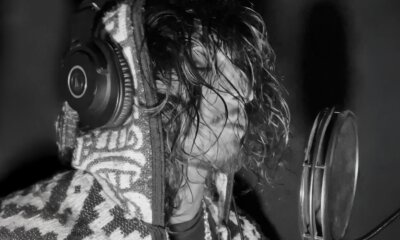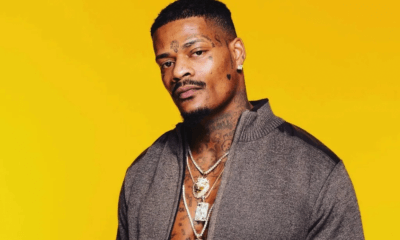Culture
Ninjai – The Little Ninja | A Look at the Ninja Universe
Published
3 years agoon

Ninjas have been one of the most beloved characters on-screen, all the way back from the 80’s to the modern-day. This character was adopted from the real-life Japanese ninja, whose job was to spy on people and assassinate them if necessary.
There have been many adaptations of the ninja in modern pop-culture movies and shows, which have been hugely successful through the years.
If we look at shows like the Ninja Turtles, Ninja Assassin, etc., we can see a massive number of cult followings generated by such movies and shows. Their appeal is broad, and people of all ages, gender, etc., can relate to the ninja characters in such shows and films.
Ninjai – The Little Ninja
The latest craze for such ninja content can be seen over the rumored release of Ninjai – The Little Ninja. Ninjai is a child with the skills of a master ninja who is on a quest to find his true identity. In his journey, he finds himself having to overcome enemies, trust new people, etc.
The storyline is one that will appeal to the fans of anime as it focuses on a character who is on a mission against all odds to find an old comrade and his true self. While some may argue that ninja-based movies are mainly about the fight between good and evil, this movie hits different because the character is a child who has to fight all kinds of foes to reach his goals.
However, this movie doesn’t just show violence and hardships but also shows the sweet and humorous side of the child and the people he meets. It also has heartwarming scenes that show the human side of the characters.
Previously, there was a web series for this show online, but it is not available anymore as it has been removed by the creators for a long time now. Followers of the show believe that this was done so that the creators could focus on producing a feature film, Ninjai – The Little Ninja.
A standout fact about this film is that the production was all executed by the Ninjai Gang. This group comprises a few friends and artists who are lovers of the animated series and wanted to do something about their passion for Ninjai – The Little Ninja.
Even without the help of big-name studios and production companies, the Ninjai Gang has been able to produce a top-quality series that is as good as most anime shows. Some people even consider it to be better.
Most anime fans predict that this feature film will be released before the end of 2022. The news about the potential release has come as music to the ears of the fans who have been passionately following its developments.
Ninjai – The Character
Ninjai is a character based on a child who has super ninja skills and is determined to find an old friend. As the search continues for his friend, he meets all kinds of people that will test his character and determination.
Shows like Avatar have taken inspiration from Ninjai, where the protagonist Aang fights against the Fire Nation even though he is only a child. He is gifted with the power of air bending, which was a lost form of art.
People believed that air bending was lost forever until Aang was found to have the power. He also could not summon his power and control it but is finally able to use his power after going through many struggles.
Aang’s story is similar to Ninjai’s, which shows that the latter clearly paved the way for shows like Avatar: The Last Airbender.
Ninjai, though a warrior with strong ninja skills, is a child who can be vulnerable to normal human emotions. He embarks on a journey with his adorable companion, Little Bird, searching for his true identity crossing rough terrains, rivers, jungles, etc. He comes across people who become his friends and foes throughout the journey.
He also shows signs of his childish optimism sometimes and does not give up when the going gets tough. Though he is a child, he is determined to reach his target, showing his maturity in times of adversity. His insecurities as a human are also noticeable as he is often seen sharing his fears and doubts with Little Bird.
Unlike other ninja characters in the anime universe, Ninjai does something which a child usually cannot comprehend – He prays for more strength to endure the problems he is facing. This shows his wisdom even though he is only a child.
Ninja vs. Samurai
Though both of them are products of Japanese martial art forms, a ninja is different from a samurai. Samurais are a class of warriors who mostly rubbed shoulders with Japan’s upper-class families, whereas ninjas were thought to be unprincipled assassins born from the lower class of society.
We can see the representation of both forms of martial arts in popular anime such as Ninja Turtles, The Last Samurai, etc. The samurai can be seen wearing hats and masks when they are on their jobs.
However, Ninjitsu requires that ninjas wear clothing that covers their whole bodies as their main objective is to hide their identity and work in stealth mode.
What’s the update with Ninjai: The Little Ninja’s feature film?
The rumor mill has been producing a lot of talks lately regarding the release of the feature film Ninjai: The Little Ninja. Fans have noticed that the Ninjai official website has been taken down under the pretense of maintenance.
However, the release of a teaser trailer by Ninjai’s creators has left fans going crazy over the internet. They have gone into investigative mode by going online, having discussions with other Ninjai fans, and adding up their knowledge of the show and its creators.
All the online talk and anime experts predict that the Ninjai: The Little Ninja feature film could be released before the end of 2022. It is understandable why a movie might take this long to make, given that almost all the production work is being done by passionate fans of the show – the Ninjai Gang.
This article contains branded content provided by a third party. The views expressed in this article are solely those of the content creator or sponsor and do not necessarily reflect the opinions or editorial stance of Popular Hustle.

You may like
-


Alain Mékani Confronts Success and Solitude in New Single ‘Quiet’
-


Siren Built Her Entire Sound in Secret and Now She’s Ready to Surface
-


JJ Tyson Proves You Can Make Metal Albums and Worship Music Without Picking Sides
-


Rising Artist Turo Rose Talks Vulnerability, Fort Worth, and Finding His Voice
-


From $300-a-Month Seamstress to Tang Heritage Luxury Icon—The Rise of Hua Ziyan
-


Daniel Hartnett Is Making Hip-Hop Beats More Accessible Than Ever
Culture
Composer Wang Gang Bridges Cultures with “Memory of Xinjiang”
Published
2 months agoon
June 12, 2025
There’s something captivating about how Wang Gang approaches traditional music—he doesn’t just preserve it, he breathes new life into it. His latest composition, “Memory of Xinjiang,” continues this approach, building on the success of “Spring Rain” from his Eastern Journey series, which earned a Global Music Award.
Wang’s new composition draws from the folk song “Our Wonderful Xinjiang,” and here’s what’s fascinating—he preserves its traditional rhythms and modal structures while incorporating modern electronic elements. The result creates an auditory experience that honestly feels like traveling across Xinjiang’s diverse geography. You can almost see the Nalati Grassland stretching endlessly, feel the imposing presence of the Tianshan mountains, and sense the shifting sands of the Kumtag Desert.

Wang acknowledges that we’re living in an era dominated by short videos and the pursuit of online traffic, yet he firmly believes in pure music’s power to anchor listener attention. His goal is transforming simple auditory perception into what he describes as a multidimensional musical experience that evokes profound emotional resonance.
What’s interesting is how Wang’s approach reflects broader changes happening in Chinese folk music. As globalization and digital technology reshape how music gets made and shared, traditional sounds are finding fresh expressions through cross-cultural partnerships and technological innovation. It’s not just about preserving the past anymore—it’s about making it relevant for today.

For “Memory of Xinjiang,” Wang assembled an international team of musicians working across borders—no small feat in today’s world. The collaboration includes violinist Zhang Yi, cellist Yu Ping, Guzheng artist He Ying, and Pipa artist Zhou Yating from China, alongside vocalist Li Sisi. Producer Mei Zi worked with Canada’s Osmanthus Music Studio for recording and mixing, proving that great music doesn’t recognize geographical boundaries.
What’s particularly striking about the piece is how it weaves together instruments from different traditions. Traditional Xinjiang and Central Asian instruments like the Sitar, Daf drum, Rawap, and Tambur blend seamlessly with digital synthesis and modern production techniques. This isn’t just musical fusion for its own sake—Wang genuinely sees it as the future of composition and music distribution. The efficiency and creative flexibility this approach offers has clearly impressed him, and honestly, the results speak for themselves.

The project reunites Wang with executive producer Fei Yun, a Chinese Canadian musician who’s built quite a reputation for curating original compositions that highlight Chinese folk elements. Her track record is impressive—previous projects include acclaimed works like “Drum Zen,” “Spring Rain,” and “The Song of the Drums” series, which have earned recognition at international art competitions. What makes her particularly valuable isn’t just her artistic insight, but her practical experience in bringing Chinese music to global audiences without losing its authenticity.
Fei Yun’s background as an independent producer gives her a unique perspective on how traditional elements can resonate with contemporary listeners worldwide. She understands both the creative and business sides of music, which is increasingly important in today’s industry. Her involvement brings a level of credibility that matters when you’re trying to bridge cultural gaps through music.
Wang’s work sits at a really interesting intersection. He’s deeply rooted in traditional Chinese culture but equally engaged with contemporary aesthetics and technology. Whether through remote collaboration or the fusion of digital and multimedia art, he’s constantly pushing boundaries while respecting the source material—a balance that’s harder to achieve than it sounds.

The composer’s range is genuinely impressive, spanning from the delicate melodies of Jiangnan Tanci to the complex rhythms of Xinjiang’s Maqam musical tradition. His ability to move between classical instruments and electronic textures speaks to a broader evolution in how Chinese music engages with the world. It’s not about choosing sides between old and new—it’s about finding ways to make them work together.
“Memory of Xinjiang” represents more than just musical innovation—it’s part of a growing movement where traditional music doesn’t simply preserve the past but actively engages with the present. Through collaborations that cross continents and genres that blend centuries of musical development, Wang is helping Chinese music find its rightful place on the global stage.
The success of projects like this suggests that audiences are genuinely hungry for music that honors tradition while speaking in contemporary terms. As technology continues to reshape how music gets created and distributed, composers like Wang are proving that cultural authenticity and modern innovation don’t have to be opposing forces. In fact, when done thoughtfully, they can enhance each other in ways that create something entirely new yet deeply familiar.
There’s something hopeful about this approach to music-making. In an era where cultural divisions often make headlines, Wang’s work demonstrates how artistic collaboration can build bridges between different worlds, creating shared experiences that transcend geographical and cultural boundaries.

Emily Pratt Slatin is not someone who speaks in half-measures. A former firefighter and paramedic lieutenant, passionate photographer, and candid writer, Slatin has built a life defined by authenticity and resilience. Through her personal blog RescueGirl557, she shares her experiences with unflinching honesty—from the challenges of an unconventional upbringing to finding peace on her Vermont farm. We recently had the opportunity to speak with Slatin about her journey, her values, and what drives her unwavering commitment to living truthfully.
The Conversation
You’ve written extensively about your early life and identity struggles. How would you describe those formative years?
I was born intersex with XX chromosomes and unmistakably female anatomy aside from one trait. From the beginning, my identity was a battleground. My family refused to accept me as their daughter, even trying to legally change the name “Emily” that nurses had written on my birth chart. But I knew who I was—I was Emily when I looked in the mirror, when I introduced myself to strangers. At 16, doctors clinically confirmed what I’d always known: I was genetically female. That sparked what my family called an “intervention,” which was really more of a tribunal where they condemned who I was. That was the moment I walked away and lost my biological family. But they were never really mine to begin with, and their absence hurt less than their expectations.
After that separation from your family, how did you build your life?
By 16, I was working at a summer camp where I’d grown up, and by 18, I had earned my EMT certification and joined a local fire department. I made a name for myself—Emily, Rescue Girl, the one who didn’t flinch, the one who stayed standing. For over two decades, I worked in emergency services, eventually becoming a Firefighter and Paramedic Lieutenant-Specialist. I led crews, taught trainees, and saved lives, all without the support or approval of the family who had cast me out. But witnessing tragedies that no human being should ever have to see takes its toll. Eventually, I chose to walk away from that career—not because I couldn’t handle it anymore, but because some chapters don’t need closure. They just need to end.
Your blog reflects an extraordinary commitment to honesty. Why is authenticity so important to you?
I’ve been told I’m too much, too intense, too much of an over-sharer, and too honest—I take every one of those labels as a compliment. I don’t do small talk or sugarcoat hard truths. On my blog, I share the most painful chapters of my life not for shock value or pity, but because truth doesn’t care if it makes people uncomfortable. I refuse to shrink myself to make others feel comfortable. My loyalty lies with the truth, no matter how harsh. I believe you either speak the truth or you’re lying—there’s no in-between. This moral stance is a throughline in my worldview. After spending so much of my early life having others try to control my narrative, living authentically is non-negotiable.
After leaving emergency services, you turned to homesteading. What does that lifestyle represent for you?
I bought a modest ranch house on 10 acres of Vermont farmland, seeking grit, utility, and freedom over comfort. I wake up every morning in a house I wired, on land I protect, with things I built from scratch. Every square inch of this life is mine. There are no name corrections needed on this property. After a lifetime of others trying to control my narrative, I’ve literally constructed a space where I answer to no one’s expectations but my own. I refuse to pay people to do what I can do myself with my own two hands. The coffee tastes stronger when you’ve earned your peace with blistered hands. The sun feels warmer when you no longer hide your skin.
Your writing often references “ghosts” and “storms.” What do these metaphors represent in your life?
The ghosts are the impressions of memory, loss, and former selves—the child I never got to be, the friends and family who faded from my life, even the person I was before trauma reshaped me. They follow us quietly, in the spaces between chaos and calm. The storm represents my emotional intensity—my rage, passion, pain, and power all at once. I used to see this intensity as a problem, but I’ve come to claim it: I am the storm, the woman who cannot be contained. And I would not change a damn thing. These aren’t just metaphors—they’re how I make sense of the chaos I’ve survived, how I process my emotional life and find meaning in everything I’ve endured.
You’ve written movingly about finding love with your wife, Amelia. What does that relationship mean to you?
With Amelia, love was not struggle or sacrifice; it was as easy, and as necessary, as breathing. She saw me as a person in a way that hit harder than I was willing to admit, because I had grown used to being overlooked or misunderstood. When she came out as transgender, I knew I loved her with a certainty that does not shake loose in the dark. Both of us faced family rejection for our love—the day I married Amelia was the day I lost what little connection I had left with my own family. Instead of letting this dual abandonment embitter us, we stood closer. We stitched a new family out of the thin air around us, made stronger precisely because it was chosen, not assigned. In the silence they left behind, we found something better than acceptance—we found belonging.
Beyond your personal journey, you’re also a creative person—a writer, photographer. How do these creative outlets shape your life?
Writing has been my lifeline—prose is what kept me alive on dark nights. I had the opportunity to be mentored by Beat poet Allen Ginsberg in my youth, which shaped my literary perspective. Photography allows me to tell visual stories, capturing moments and places with the same honesty I bring to my writing. I’m not built for mediocrity; I don’t fear obsession, I embrace it. Anything worth doing deserves my full force, my entire intellect, and my unwavering focus. That’s how I approach everything, from fixing a tractor to composing the perfect shot. Mastery, to me, is a form of both personal discipline and self-expression.
After everything you’ve been through, what values guide your life now?
Authenticity is my North Star—I’ve never relinquished my right to define myself. Courage and resilience are second nature to me; sometimes bravery is quiet and stubborn, reaching for something better even if your hands are shaking when you do it. Compassion runs deep—ironically, the very girl whom my parents called selfish and wrong grew up to devote decades to rescuing strangers and caring for a child who wasn’t legally mine. And integrity infuses everything—I simply will not live a lie. I will speak up, even if my voice shakes. I will cut ties, even if my heart aches. I will stand in my own skin, unashamed and unafraid.
Finding Truth in Resilience
Emily Pratt Slatin’s story is ultimately one of hope—hope in finding love that accepts you fully, hope in creating family and community from scratch, hope in the simple healing found in nature and honest work. After facing rejection, trauma, and loss, she has transformed pain into strength and isolation into self-sufficiency.
“I didn’t need happy,” she reflects. “I needed honest. And that is exactly what I finally have.”
That hard-won honesty is the compass by which Slatin steers her life. It makes her voice powerful and her presence authentic—a testament to a woman who chose to live truthfully, love deeply, and never let others define her fate.
Business
Building Healthier Futures: How For The Better Inc. is Leading Change with the Help of Local Businesses
Published
6 months agoon
February 15, 2025
In Brooklyn, For The Better Inc., a nonprofit founded by Rasheedat Ajala, is driving transformative change in youth health and wellness. But the organization isn’t doing it alone. With strategic support from local business partners like Ponce Bank and Black Health, For The Better Inc. is building healthier futures for minority youth through collaborative efforts that bring community resources together for greater impact.
The Power of Partnerships in Community Health
For The Better Inc. believes that community-driven solutions are key to sustainable health improvements. By partnering with businesses that share its mission, the nonprofit has been able to expand its reach, amplify its impact, and fund more programs for Brooklyn’s underserved youth. These partnerships provide crucial financial backing, resources, and in-kind support that allow the organization to deliver hands-on health programs and workshops that resonate with teens.
“Health education is essential, but it’s just the beginning,” says Ajala. “With the help of partners like Ponce Bank and Black Health, we’re able to bring these programs to life and reach even more young people. Our partners are integral to our mission; they understand the importance of health equity and the impact it has on every community.”

Partnership Success Stories: Making a Difference Together
Ponce Bank’s partnership with For The Better Inc. began with a shared commitment to fostering community resilience. By funding key programs like Better Health for Teens, Ponce Bank has enabled hundreds of Brooklyn teens to access nutrition education, cooking classes, and fitness workshops that wouldn’t otherwise be available to them.
“As a community-centered bank, we believe in investing in programs that make a tangible difference,” says a representative from Ponce Bank. “Our partnership with For The Better Inc. allows us to give back in a meaningful way. We’re proud to support an organization that’s dedicated to changing lives, one healthy choice at a time.”
Black Health has also played a critical role, providing resources for health screenings, mental wellness workshops, and nutritional guidance. By aligning with For The Better Inc., Black Health reinforces its commitment to addressing disparities in health education and access for minority communities. Together, they’re creating a foundation for a healthier future by empowering teens to take control of their well-being.
“Our collaboration with For The Better Inc. allows us to combine our expertise and resources,” says a spokesperson from Black Health. “It’s not just about addressing health issues but about creating lasting change by instilling healthy habits in the next generation.”
Expanding Impact: New Sponsorship Opportunities
For The Better Inc. is actively seeking new partners to join its mission and support its growing initiatives. Upcoming sponsorship opportunities include:
- Nutrition Workshops Series: A series of monthly cooking and nutrition classes for teens, where partners can provide funding, in-kind donations, or branded materials to support interactive sessions focused on healthy eating.
- Teen Wellness Challenges: Sponsors can help power upcoming challenges, such as the “Step Up for Health” fitness challenge, where teens log daily steps or physical activities, with sponsors recognized for contributing to prizes, awards, and event materials.
- Annual Community Health Fair: A large-scale event planned for Spring, bringing together local families, teens, and health experts for a day of free health screenings, fitness activities, and wellness talks. Sponsors can have dedicated booths, brand placements, and engage with the community directly.
Ajala emphasizes that these collaborations are mutually beneficial: “By partnering with us, businesses not only contribute to a crucial cause but also reinforce their role as a community ally. Together, we’re not just building programs; we’re building a legacy of health and empowerment for the next generation.”
Join Us in Building a Healthier Future
For The Better Inc. continues to expand its reach, and with every new partnership, its impact grows stronger. As a partner, you’re more than a sponsor; you’re a cornerstone of a movement that prioritizes health, equity, and opportunity for all. By aligning with For The Better Inc., you have the chance to make a difference that will resonate across generations.
Are you ready to help build a healthier, more equitable future? Partner with For The Better Inc. and become part of a legacy that empowers minority youth to lead healthier lives. Together, we can bring meaningful change to our community.
Partner with us today. Together, we can build a healthier, more equitable future for our community’s youth.



Alain Mékani Confronts Success and Solitude in New Single ‘Quiet’

Siren Built Her Entire Sound in Secret and Now She’s Ready to Surface

JJ Tyson Proves You Can Make Metal Albums and Worship Music Without Picking Sides

Rising Artist Turo Rose Talks Vulnerability, Fort Worth, and Finding His Voice

From $300-a-Month Seamstress to Tang Heritage Luxury Icon—The Rise of Hua Ziyan

Daniel Hartnett Is Making Hip-Hop Beats More Accessible Than Ever

From Playing Small to Reigning Supreme: How Melody Sheard Empowers Single Women

Vienna’s Elite Gather for ‘Spy Capital 2’ Red Carpet Premiere

Media Executive Barrett Dungy Goes Big with One Culture Media Group Launch

Selene Makes Her Industry Debut with Mythology-Inspired Album ‘SELENE’

Caplin & Massiah Serve Up Genre-Blending Debut with ‘Chemistry’

Composer Wang Gang Bridges Cultures with “Memory of Xinjiang”

Rising Artist Erik Aronesty Is Already Breaking Every Rule He Can Find

Raybot Explores Existential Questions in Upcoming EP ‘Cosmic Purpose’

Katie Hamden Talks New EDM Single ‘NOBODY ELSE’

Jason Luv Dominates Charts While Inspiring New Wave of Multi Career Artists

Harley West | Inside the Mind of a Social Media Star on the Rise

Raw Fishing | Franklin Seeber, Known As “Raww Fishing” Youtuber Story

Jordana Lajoie Transforms Montreal Roots into Hollywood Success Story

A New Hollywood Icon Emerges in Madelyn Cline

Who is Isaiah Silva – The Story Behind The Music

Tefi Valenzuela Pours Her Heart into New Song About Breaking Free

G FACE Releases His New Single “All up,” and It’s Fire

Gearshift to Stardom: Nikhael Neil’s Revolutionary Journey in the Automotive Industry

Kaia Ra | Perseverance That Built a Best-Selling Author

Holly Valentine | Social Media Influencer & Star Success Story

Tadgh Walsh – How This Young Entrepreneur is Making a Name for Himself

Kate Katzman | Breaking Into Hollywood and Embracing Change

King Lil G | West Coast Hip Hop Genius Rises to Face With Ease

Lil Ugly Baby XXX’s “Who?” – The Mixtape to Boost Your Playlist

Tefi Valenzuela Pours Her Heart into New Song About Breaking Free

Kate Katzman | Breaking Into Hollywood and Embracing Change

Holly Valentine | Social Media Influencer & Star Success Story

Kaia Ra | Perseverance That Built a Best-Selling Author

Lil Ugly Baby XXX’s “Who?” – The Mixtape to Boost Your Playlist

Samuel Chewning Explains How Fitness Should Be A Personal Journey

Trending
-

 Business3 years ago
Business3 years agoJason Luv Dominates Charts While Inspiring New Wave of Multi Career Artists
-

 Entertainment2 years ago
Entertainment2 years agoHarley West | Inside the Mind of a Social Media Star on the Rise
-

 Culture3 years ago
Culture3 years agoRaw Fishing | Franklin Seeber, Known As “Raww Fishing” Youtuber Story
-

 Culture2 years ago
Culture2 years agoJordana Lajoie Transforms Montreal Roots into Hollywood Success Story
-

 Culture1 year ago
Culture1 year agoA New Hollywood Icon Emerges in Madelyn Cline
-

 Entertainment7 months ago
Entertainment7 months agoWho is Isaiah Silva – The Story Behind The Music
-

 Entertainment2 years ago
Entertainment2 years agoTefi Valenzuela Pours Her Heart into New Song About Breaking Free
-

 Culture3 years ago
Culture3 years agoG FACE Releases His New Single “All up,” and It’s Fire

